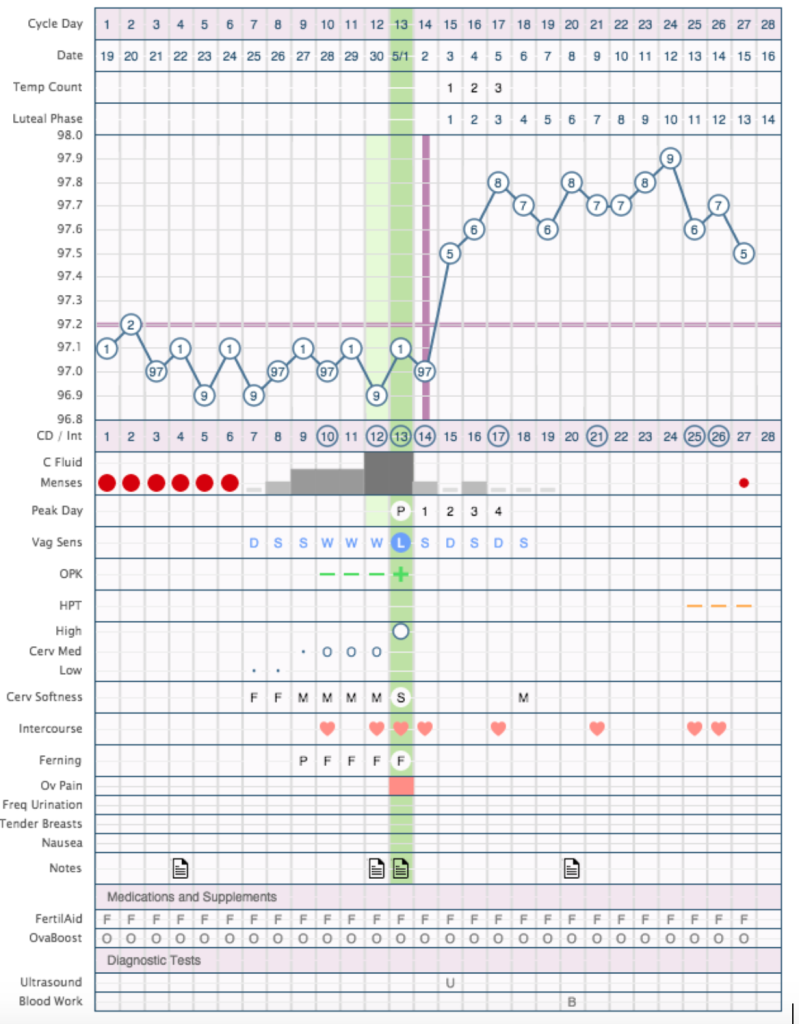This guest post was written by Austyn Smith
The book “Taking Charge of your Fertility” by Toni Weschler provides deep insights into what happens in a woman’s body during a typical menstrual cycle. Learning about these changes in detail helps women become very in tune with their body’s physical signals of fertility (or lack thereof). In part one of this series, we discussed using Toni’s Fertility Awareness Method to help in troubleshooting infertility issues naturally, and ultimately achieving pregnancy. In part 2, we will discuss using this same method as a means for birth control.
Natural Birth Control After Baby
I have successfully used the Fertility Awareness Method (FAM) for natural birth control for over four years, and have loved it. It entails charting your body temperature, your cervical mucus, and your cervical position as a means for noting your fertile and infertile times, and then planning intercourse accordingly. Although this method is not for everyone, it can be a great option for women who prefer not to use traditional birth control or have adverse reactions to it (myself). Using this method does require a bit of planning and consistency in order to be effective, so it is ideal for the organized or schedule-driven mama.
Plan on charting two full menstrual cycles before you begin using this method so that you can get a true understanding of charting, how it works, what it all means, and identifying your own body’s cues and signals of fertility. During each cycle you will be taking a daily basal body temperature (you need a special thermometer for tracking), recording cervical mucus, and cervical positioning (optional). A sample chart of a typical cycle is below.
As a reminder, there are three phases of a typical menstrual cycle: the pre-ovulatory infertile phase, the fertile phase, and the post-ovulatory infertile (luteal) phase. I recommend re-reading FAM part 1 to review the basics of the signs of fertile and infertile phases, before continuing on. I also highly recommend reading the book in detail before trying this method in order to get a clear picture of the procedures in detail. At any rate, here is an overview.
Phase One: Pre-Ovulatory Infertile Phase Rules
The first phase of a cycle begins on the first day of bleeding during your period. During this phase, there are two rules to follow.
First five days rule
You are only “safe” to have intercourse during the first 5 days of a menstrual cycle if you have had an obvious temperature shift 12-16 days prior.
Having this shift means that ovulation has indeed occurred and the bleeding you are experiencing is not ovulation spotting or implantation bleeding. Remember sperm can live for up to five days in a fertile environment, so any time after these first five days consider yourself potentially fertile, even if you are still bleeding. You may consider yourself “safe” beyond the first five days if you then keep the second rule.
Dry Day Rule
Before you ovulate, you are safe on the evening of every dry day—meaning you do not have any cervical discharge during the course of the entire day. If you have been dry and then have intercourse, the next day you must be careful since semen may mask cervical discharge. If at the end of a day after intercourse you have been dry all day, consider yourself safe once again (remember, sperm cannot survive in a dry environment).
Phase Two: Fertile Phase
Ideally, you are only having unprotected sex when you know for sure you are in your infertile phase. If you do decide to have sex during your fertile phase, you will need to use a barrier of some type (like condoms—we are huge fans of these), or explore other areas of arousal and climax without penetration. A woman’s egg once released survives only 24-48 hours. However, if the uterine environment is right, sperm can survive for several days, so there is a range on either side of ovulation day where you must consider yourself potentially fertile. To err on the side of caution, assume most women have an 8-10 day range of fertility. As a basic review, the signs of fertility include:
- Cervical mucus changes from dry to sticky, then creamy, then eggwhite (extremely fertile), to sticky or dry, and finally menstruation.
- Cervical positioning changes from firm, low, and closed to soft, high, open, and wet and then closed and low again.
- Basal Body Temperature Shifts: a spike of several tenths of a degree which remains high for 3 consecutive days will indicate that ovulation has occurred. Remember you need a special thermometer for tracking.
- Ovulatory Pain: Some women experience cramping in the lower abdomen on one side indicating ovulation is occurring.
Phase Three: Post-Ovulatory Infertile Phase
During this phase remember the Temperature Shift Rule.
Temperature Shift Rule
You are “safe” the evening of the third consecutive day your temperature is above the coverline.
Review how to chart temperatures and calculate coverline here. Essentially, the first day there has been a temperature rise by 2/10 of a degree, and has stayed elevated for 3 consecutive days, you can be sure you have ovulated. Highlight the previous 6 temperatures, and identify the highest of those. Draw your coverline on the chart that is one degree higher than the highest of those temperatures.
You are considered infertile at 6pm on the third consecutive night your basal body temperature is above the coverline. If your temperature is on or below the coverline during those 3 days, you must start over once your temperatures are back above the line. Remember, sex is still okay, only you must use a barrier method.
There are a few exceptions to these rules that will throw your body off a little bit—being sick, traveling, breastfeeding, or sleeping poorly for instance. So definitely review the book in detail before trying out this method.
Monitoring and charting fertility signs not only helps women understand their fertility in a very detailed manner, but can also serve as a diagnostic tool for infertility, as well as a means of natural birth control. It can be a great alternative for women who do not want added hormones, surgery, or the pressure of remembering to take a pill for birth control. I have found great success in using the Fertility Awareness Method both to prevent pregnancy, and to achieve pregnancy when I want to conceive. You may find a copy of Toni Weschler’s book here, and more information and community resources about using the Fertility Awareness Method at Taking Charge of your Fertility or ovagraph.com.



No Comments yet!